Indigenous dairy breeds of cattle
|
|
Gir
- This breed is otherwise known as Bhadawari, Desan, Gujarati, Kathiawari, Sorthi, and Surati.
- Originated inGir forests of South Kathiawar in Gujarat also found in Maharashtra and adjacent Rajasthan.
- Basic colours of skin are white with dark red or chocolate-brown patches or sometimes black or purely red.
- Horns are peculiarly curved, giving a ‘half moon’ appearance.
- Milk yield ranges from 1200-1800 kgs per lactation.
- Age at first calving 45-54 months and inter calving period from 515 to 600 days.
- This is known for its hardiness and disease resistance.
|
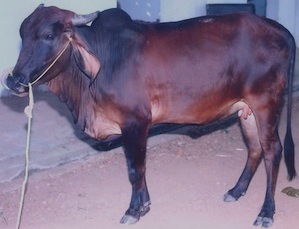 |
Red Sindhi
- This breed is otherwise called as Red Karachi and Sindhi and Mahi.
- Originated in Karachi and Hyderabad (Pakistan) regions of undivided India and also reared in certain organized farms in our country.
- Colour is red with shades varying from dark red to light, strips of white.
- Milk yield ranges from 1250 to 1800 kg per lactation.
- Age at first calving 39-50 months and inter calving period from 425-540 days.
- Bullocks despite lethargic and slow can be used for road and field work.
|
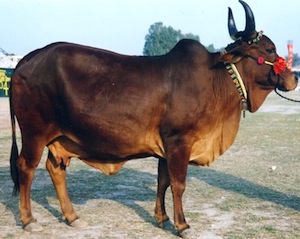 |
Sahiwal
- Originated in Montgomery region of undivided India.
- This breed otherwise known as Lola (loose skin), Lambi Bar, Montgomery, Multani, Teli.
- The best indigenous dairy breed.
- The colour is reddish dun or pale red, sometimes flashed with white patches.
- Heavy breed with symmetrical body having loose skin.
- The average milk yield of this breed is between 1400 and 2500 kg per lactation.
- Age at first calving ranges from 37 to 48 months and the calving interval is 430 to 580 days.
|
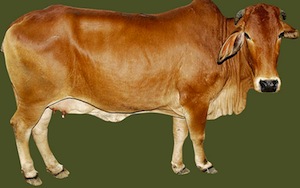 |
Indigenous Draught breeds of cattle
|
|
Hallikar
- Originated from the former princely state of Vijayanagarm, presently part of Karnataka.
- The colour is grey or dark grey.
- They are compact, muscular and medium size animal with prominent forehead, long horns and strong legs.
- The breed is best known for its draught capacity and especially for its trotting ability.
|
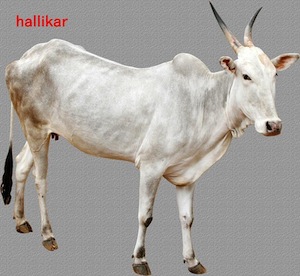 |
Amritmahal
- Originated in Hassan, Chikmagalur and Chitradurga district of Karnataka.
- The Maharajahs of Mysore developed this breed.
- Amiritmahals are grey cattle but their shade varies from almost white to near black.
- The muzzle, feat and tail are usually black.
- Horns are long and end in sharp black points.
|
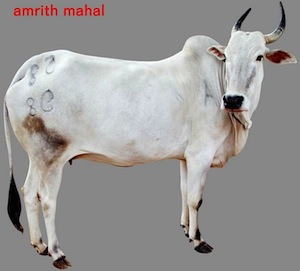 |
Khillari
- Originated fromSholapur and Sitapur districts of Maharashtra.
- Closely resembles Hallikar breed.
- Grey-white in colour. New borns have dusty red colour which disappears in couple of months.
- Long horns turn forwards in a peculiar fashion. The horns are generally black, sometimes pinkish.
- Bullocks are fast and powerful.
|
 |
Kangayam
- Also known as kongu and konganad.
- Originated in Kangayam, Dharapuram, Perundurai, Erode, Bhavani and part of Gobichettipalayam taluk of Erode and Coimbatore district.
- The Kangayam breed was developed by the efforts of the late Pattogar of Palayakottai, Sri N. Nallathambi Sarkari Manradiar.
- Coat is red at birth, but changes to grey at about 6 months of age.
- Bulls are grey with dark colour in hump, fore and hind quarters.
- The horns are spread apart, nearly straight with a slight curve backwards.
- Cows are grey or white. However, animals with red, black, fawn and broken colours are also observed.
- The eyes are dark and prominent with black rings around them.
- Moderate size with compact bodies.
|
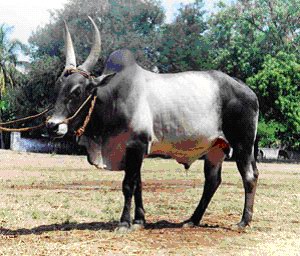 |
Bargur
- Found around Bargur hills in Bhavani taluk of Erode district.
- Developed for work in uneven hilly terrains.
- Bargur cattle are of brown colour with white markings. Some white or dark brown animal are also seen.
- Animals are well built, compact and medium in size.
- Known for their speed and endurance in trotting.
- Cautious in behaviour and tends to remain away from strangers.
|
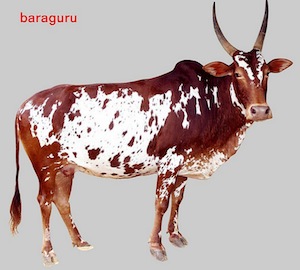 |
Umblachery
- It is otherwise called asJathi madu, Mottai madu, Molai madu, Therkathi madu.
- Originated inThanjavur, Thiruvarur and Nagappattinam districts of Tamil Nadu.
- Suitable for wet ploughing and known for their strength and sturdiness.
- Umblachery calves are generally red or brown at birth with all the characteristic white marking on the face, on limbs and tail.
- The legs have white markings below the hocks like socks.
- The practice of dehorning of bullocks is peculiar in Umblachery cattle. Unlike in other breeds the bullocks are dehorned.
|
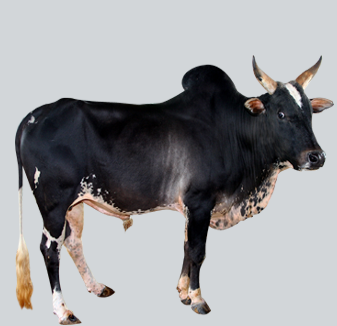 |
Pulikulam
- This breed is commonly seen in cumbum valley of Madurai district in Tamilnadu.
- Also known as Jallikattu madu, kidai madu, sentharai.
- Small in size, usually grey or dark grey with farm markings.
- Well- developed hump.
- Mainly used for penning in the field.
- Useful for ploughing.
- Presence of reddish or brownish spots in muzzle, eyes, switch and back is the characteristic feature of this breed.
- They have the typical backward curving horns of Mysore type cattle.
|
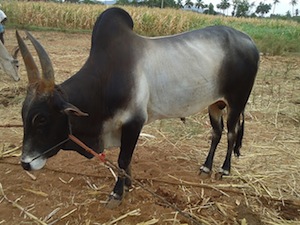 |
Indigenous Dual purpose breeds of Cattle
|
|
Tharparkar
- Originated inTharparkar district (Pakistan) of undivided India and also found in Rajasthan.
- Otherwise known as White Sindhi, Gray Sindhi and Thari.
- They are medium sized, compact and have lyre-shaped horn.
- Body colour is white or light grey.
- The bullocks are quite suitable for ploughing and casting and the cows yield 1800 to 2600 kg of milk per lactation.
- Age at first calving ranges from 38 to 42 months and inter calving period from 430 to 460 days.
|
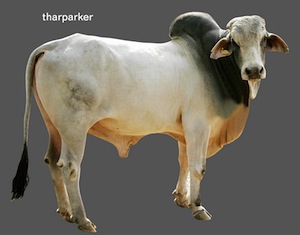 |
Hariana
- It was originated from Rohtak, Hisar, Jind and Gurgaon districts of Haryana and also popular in Punjab, UP and parts of MP.
- Horns are small.
- The bullocks are powerful work animals.
- Hariana cows are fair milkers yielding 600 to 800 kg of milk in lactation.
- The age at first calving is 40 to 60 months and calving interval is 480 to 630 days.
|
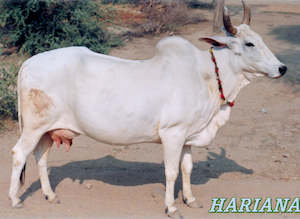 |
Kankrej
- It is otherwise called as Wadad or Waged, Wadhiar.
- Originated from Southeast Rann of Kutch of Gujarat and adjoining Rajasthan (Barmer and Jodhpur district).
- The horns are lyre-shaped.
- Colour of the animal varies from silver-grey to iron-grey or steel black.
- The gait of Kankrej is peculiar called as 1 ¼ paces (sawai chal).
- Kankrej is valued for fast, powerful, draught cattle. Useful in ploughing and carting.
- The cows are good milkers, yielding about 1400 kg per lactation.
|
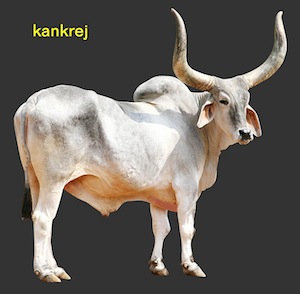 |
Ongole
- Otherwise known as Nellore.
- Home tract is Ongole taluk in Guntur district of Andhra Pradesh.
- Large muscular breed with a well developed hump.
- Suitable for heavy draught work.
- White or light grey in colour.
- Average milk yield is 1000 kg per lactation. Age at first calving is 38 to 45 months and the intercalving period is 470 days.
- Exported to south East Asian and American countries for development of meat cattle.
|
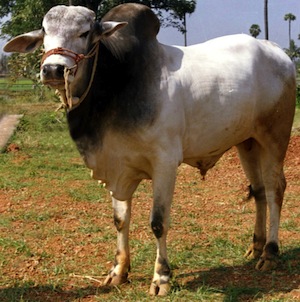 |
Krishna Valley
- Originated from black cotton soil of the water shed of the river Krishna in Karnataka and also found in border districts of Maharastra.
- Animals are large, having a massive frame with deep, loosely built short body.
- Tail almost reaches the ground.
- Common colour grey white with a darker shade on fore quarters and hind quarters in male. Adult females are more whitish in appearance.
- The bullocks of this breed are powerful animals useful for slow ploughing, and valued for their good working qualities.
- The cows are fair milkers, average yield being about 900 kg per lactation.
|
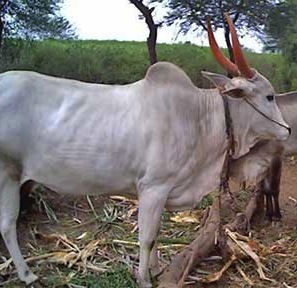 |
Deoni
- This breed otherwise known as Dongerpati, Dongari, Wannera, Waghyd, Balankya, Shevera.
- Originated in Western Andra Pradesh and also found in Marathwada region of Maharashtra state and adjoining part of Karnataka.
- Body colour is usually spotted black and white.
- Age at first calving ranges from 894 to 1540 days.
- Milk yield ranges from 636 to 1230 kg per lactation.
- Caving interval averages 447 days.
- Bullocks are suitable for heavy cultivation.
|
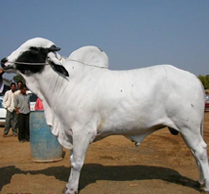 |